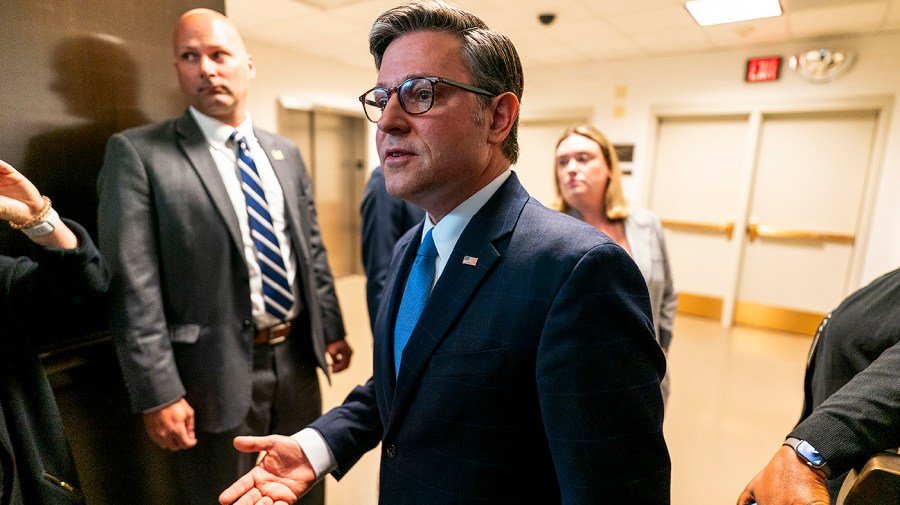
Republican leaders are making plans for a new, longer continuing resolution (CR) to fund the government at current levels as the government shutdown drags into its fourth week.
Consensus is growing that the GOP-crafted “clean” CR to fund the government through Nov. 21 — which passed the House in September but has been voted down 11 times in the Senate as Democrats make demands on health care — will no longer allow enough time to work out regular full-year appropriations.
But the timeline of the new measure is the subject of debate.
Several options are under consideration, multiple GOP leadership sources tell The Hill, including one lasting until late January. One of those sources said that date seems to have the most support right now, while stressing the plans are in flux.
A full-year CR through at least Sept. 30 — the end of the fiscal year — has also been discussed.
That kind of long-term option is preferred by some hard-line Republicans who would prefer to avoid any spending increases or new leverage points for Democrats. Members of the House Freedom Caucus have previously argued for a yearlong CR.
But such a measure would be abhorred by members of the Appropriations committees who have been working to set new spending levels, something Congress hasn’t done since March 2024.
Some Republicans have floated a mid-December CR to finish regular appropriations sooner, but that would outrage hard-liners who want to avoid a holiday deadline that might put pressure on members to support a massive omnibus spending bill — perhaps with health care deals attached.
Setting a new stopgap date would require Speaker Mike Johnson (R-La.) to bring the House back to the Capitol, something he has avoided so far as a means of pressuring Democrats to back the GOP’s existing spending measure.
Senate Majority Leader John Thune (R-S.D.) on Monday responded affirmatively when asked whether it was time to start thinking about the House coming back and extending the time period covered by the continuing resolution.
“Every day that passes, we’ve got less time to fund the government,” Thune told reporters.
The delay in reopening the government could push Republicans into “a long-term CR mode,” Thune warned.
“I just don’t think that’s the way that we ought to be funding the government around here, but every day that passes, it becomes more possible as an eventuality,” Thune said.
Johnson also signaled in a press conference on Tuesday that Congress might need a new stopgap, recognizing that funding the government through Nov. 21 might not provide enough time for appropriators to finish up full-year appropriations.
“That’s becoming a very dicey prospect right now because we need every single day,” Johnson said.
The Speaker said Nov. 21 was not a “random date,” but one chosen by Republican and Democratic appropriators because they expected it would take seven additional weeks to finish the appropriations process.
The House has moved to go to a conference negotiation with the Senate to negotiate three of the 12 regular appropriations bills — funding for the departments of Veterans Affairs and Agriculture, the Food and Drug Administration, rural development, military construction, and the legislative branch — but Senate Democrats have prevented that conference from moving forward amid the shutdown.
House Freedom Caucus Chair Andy Harris (R-Md.), who chairs the House Appropriations subcommittee responsible for the Agriculture and FDA funding bill, said Monday he thinks that package could be completed quickly.
“I think we’re within days of actually coming to a final negotiated agreement on the first three bills – MilCon-VA, Leg branch, and Ag. So as soon as we come back in, I suspect within a week, that that bill will be on the House floor,” Harris said.
Johnson has rebuffed suggestions to bring the House back into session to continue to pass more appropriations bills on the House floor, saying appropriators are working during the shutdown and will be ready to bring bills to the floor once the government opens.
The crux of the shutdown standoff is that Democrats withholding support for a stopgap are seeking negotiations and assurances on health care issues, like extending expiring Affordable Care Act subsidies, while Republicans say they will refuse to negotiate on health care matters until Democrats vote to reopen the government.
And unless Senate Republicans use the “nuclear option” in the Senate to bypass the 60-vote rule — which leaders have so far ruled out, despite members like Reps. Chip Roy (R-Texas) and Marjorie Taylor Greene (R-Ga.) suggesting they do so — they will have to get buy-in from Senate Democrats to send a longer CR to President Trump’s desk.
Thune has said he offered Democrats a vote on extending the expiring ObamaCare subsidies when the government reopens, without any other assurances — but Senate Minority Leader Chuck Schumer (D-N.Y.) rejected that proposal.
“We have offered them several off-ramps now,” Thune said after meeting with President Trump at the White House with other Senate Republicans on Tuesday.
Johnson met with Trump in the Oval Office for around two hours Monday night, he told reporters.
“He is not going to negotiate with the Democrats who have the American people hostage,” Johnson said. “We’re not going to pay a ransom to reopen the federal government.”
Democratic leaders are seeking to meet with Trump, too. Schumer said he and House Minority Leader Hakeem Jeffries (D-N.Y.) reached out to Trump on Tuesday seeking a sit-down “to resolve the health care crisis” and “negotiate in a serious way.”
Johnson and Jeffries also met over the weekend, but Jeffries on Tuesday declined to answer whether the leaders discussed extending the CR timeline.
Wednesday marks the 22nd day of the government shutdown, making it the second-longest shutdown in history behind the 35-day shutdown in 2018-19 during the first Trump administration. It’s also the longest full government shutdown because the 2018-19 lapse occurred while some departments were funded.
Al Weaver contributed.

